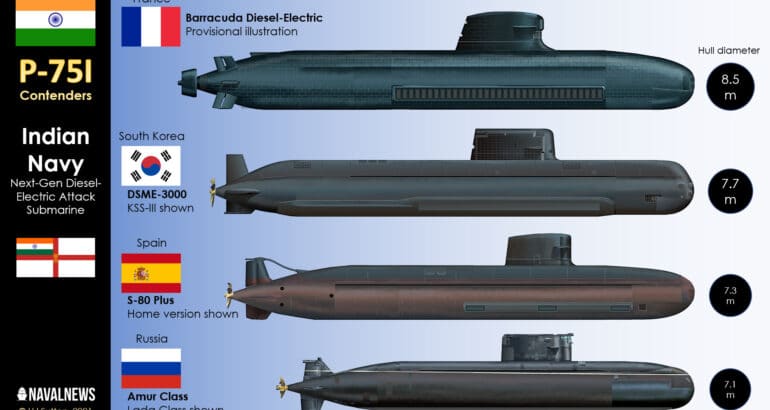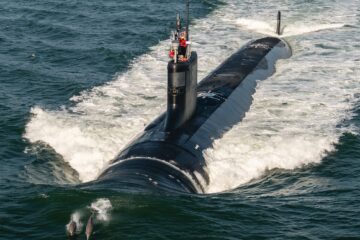There are four contenders for the Indian navy’s next-generation P75I submarine. They are currently submitting design proposals to the Indian Government. Whatever the outcome the boats are expected to all be built in India. So the deal will factor in political and industrial considerations as well as naval requirements.
The four contenders are the Barracuda from France, the S-80-Plus from Spain, DSME-3000 from South Korea and Amur design from Russia. Germany had also been a contender but recently said that they dropped out.
All of the contenders have their merits and it is likely to be a tough choice for the Indian Navy. Below we outline the different designs.
The Indian Navy’s detailed requirements have not been shared. Based on reports and analysis of their current capabilities, investments and threat focuses, two things seem sure. The first is that P75I will have AIP (air independent power). The second is that they would prefer a VLS to launch Brahmos anti-ship missiles. Taken together, the P75I will have to be much larger than previous Indian navy conventional submarines.
Both the AIP and VLS will present challenges and difficult decisions. Like all major submarine projects, trade-offs will have to get made. India has developed its own fuel cell AIP which it is planning to fit to the current French-designed Kalvari Class (Scorpene type). This is a logical choice for the P75I also, particularly from the perspective of indigenous industry. However the Indian Navy is likely to be very interested in the AIP already available with the designs. Incorporating the local AIP would increase development risks, and close off opportunities to access better AIP systems.
The VLS will be a challenge because all the contenders are relatively small boats. It is unclear how dependent the contract will be on a VLS, or whether alternative missile options will be considered.
1. Barracuda Class Submarine
France’s Naval Group is believed to be offering a diesel-electric version of their Barracuda nuclear submarine. The nuclear version is already in service with the French Navy (Marine Nationale) as the Suffren Class. Being from the same lineage as the Kalvari Class currently being built in India, it can be seen as a strong contender.
The diesel-electric version could have some design features from the SMX-3.0 design. This was exhibited at DEFEXPO in India in 2020. This may include the sail-mounted hydroplanes (as opposed to hull mounted on Suffren) and AIP. The French AIP system uses fuel-cells with a diesel reformer to eliminate the need for onboard hydrogen storage. It has been shore tested for years.
Perhaps the largest design advantage of the Barracuda is simply its size. The hull diameter of around 8.5 meters is the largest of the competitors. This should make it comparatively less challenging to fit a VLS, even with the massive Brahmos missile. The related SMX Ocean concept already has a VLS, and the baseline Barracuda class can anyway launch MdCN land-attack cruise missiles.
Other noteworthy features of the French design are likely to include X-form rudders and a pump-jet. This latter feature may also be of interest in India’s nuclear submarine projects.
We can speculate that French nuclear submarine technologies and/or access to extra-large uncrewed underwater vehicle (XLUUV) technologies, may also be a factor. Naval Group recently revealed that they have had an XLUUV demonstrator in the water since last year.
2. DSME-3000, South Korea’s Missile Submarine
South Korea has recently spread its wings and entered the submarine export game, selling boats to Indonesia. They are understood to be proposing an export version of their home-grown KSS-III design. This is a relatively large non-nuclear boat, likely second only to the Barracuda.
The type comes with German based fuel-cell AIP. The layout, with a hull section essentially dedicated to AIP, suggests that it would not be too challenging to swap it for the Indian alternative.
And South Korea is ahead of most countries in the race to fit lithium-base battery technology to submarines. This promises to extend the endurance of submarines when running on batterie. Naturally this may be attractive to the Indian Navy, even potentially diminishing the importance of AIP.
Its differentiating feature is that it already comes with a six or ten round VLS. In South Korean service this is expected to carry the Hyunmoo 4-4 missile, which is roughly equivalent to India’s K-15 Sagarika but without a nuclear option. While exact dimensions and weights are not available, this at least implies that it could accommodate the similarly sized Brahmos.
Carrying a VLS in such a small submarine likely needs some trade-offs, like fewer weapons slots in the regular torpedo room. But overall the South Korean design seems balanced and highly capable.
3. Spain’s New Entrant: S-80 Plus
Another new country to submarine exports, Spain’s Navantia is offering a variant of their latest S-80 plus design. This is a larger boat than the Scorpene design (per India’s Kalvari Class), but smaller than the South Korean or French options.
The AIP is a fuel-cell system with bio-ethanol reformer. So like the French system there is no need for hydrogen storage. Currently Spain’s S-80 Plus boats are not running with AIP, but the system is being tested and should go to sea in the next few years.
It is unclear whether Navantia is proposing a VLS. The design was always intended to be compatible with land-attack cruise missiles shot from the torpedo tubes.
4. The Russian Option: Amur
Essentially the export versions of the Lada Class, the Amur family of submarines has been offered for several years. Russia already has strong ties with the Indian Navy and some related Kilo Class submarines are still in their service. The Amur shares some lineage to the Kilo but features a single-hull configuration.
Despite having the smallest hull diameter of the contenders (1.5 meters less than the Barracuda), design models have frequently shown a VLS. This seems to have been for smaller Kalibr sized weapons rather than the Brahmos however.
Another challenge for the Amur designs could be AIP. Russia has yet to develop an AIP system for its Lada Class. Possibly the Indian AIP system is key to the proposal.
Like France, Russia may be seen as having a ‘home advantage’ because of the strong historic relationship. There have been reports that Russia views this as an opportunity to joint-develop the next generation of non-nuclear submarine. How this sits with other reports of the same thing with China remains unclear.






